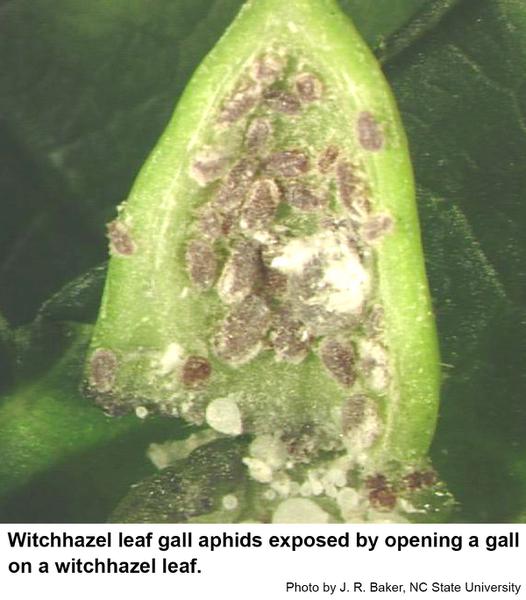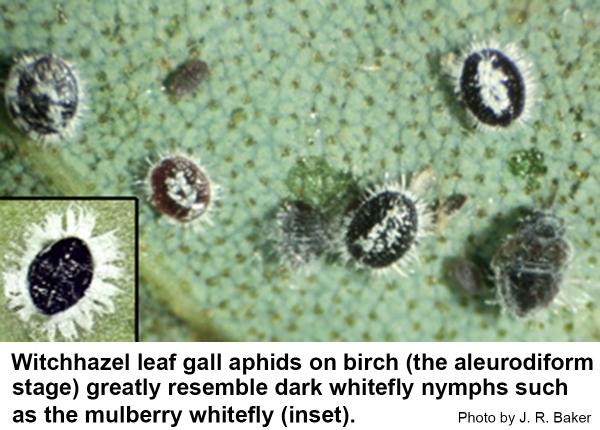Description and Biology
The witchhazel leaf gall aphid, Hormaphis cornu, is most often noticed as the "aleurodiform" (whitefly form) on birch leaves in late summer or fall. In late summer, these whitefly-like aphids give birth to nymphs that develop wings. These winged aphids fly back to witchhazel and give birth to a generation of wingless females and males that mature and lay the overwintering eggs. In the next spring, the overwintering eggs hatch and the young aphids induce witchhazel to develop leaf galls inside of which the aphids grow and reproduce. The galls are cone-shaped so these aphids are sometimes called, "witchhazel cone gall aphids." In late spring or early summer, the new aphids emerge from the galls and fly to birch where their offspring feed on the leaves as a stage that more closely resembles a scale insect or a mulberry whitefly nymph (the "aleurodiform") than an aphid. The alternation of hosts is well known for other aphids (woolly apple aphid: apple and elm; woolly alder aphid: maple and alder; green peach aphid: peach and many other hosts).
Host Plants
Witchhazel leaf gall aphids cause conical galls on the leaves of witchhazel. Sooty molds do not seem to be associated with this stage. On birch, the aleurodiform stage excretes honeydew in which sooty molds can grow to further disfigure the birch foliage.
Residential Recommendation
Insecticidal soap, Orthene or one of the other contact insecticides should give adequate control of the aphid on birch. Consider using one of the horticultural oils as oils are reputed to remove sooty molds more rapidly than other pesticides. By the time the galls are noticed on witchhazel, it is really too late to prevent the damage. Orthene applied just at bud break should control the galls next year.
References
- American Witchhazel (Hamamelis virginiana L.). Stritch, L. No Date. United States Department of Agriculture Forest Service Plant of the Week.
- Galls on trees. Anonymous. No Date. Missouri Botanical Garden.
- Horticultural Oils for Ornamental Plants. Frank, S., J. R. Baker and S. B. Bambara. 2018. Entomology Insect Notes, NC State Extension Publications
- Which witch hazel should be in your yard? Zaworski, K. 2013. Smart Gardener, Chicago Botanic Garden.
- Witch-hazel cone gall aphid. Anonymous. 2013. Wikipedia, The Free Encyclopedia.
- Extension Plant Pathology Publications and Factsheets
- Horticultural Science Publications
- North Carolina Agricultural Chemicals Manual
For assistance with a specific problem, contact your local Cooperative Extension center.
Publication date: July 13, 2013
Reviewed/Revised: May 11, 2021
Recommendations for the use of agricultural chemicals are included in this publication as a convenience to the reader. The use of brand names and any mention or listing of commercial products or services in this publication does not imply endorsement by NC State University or N.C. A&T State University nor discrimination against similar products or services not mentioned. Individuals who use agricultural chemicals are responsible for ensuring that the intended use complies with current regulations and conforms to the product label. Be sure to obtain current information about usage regulations and examine a current product label before applying any chemical. For assistance, contact your local N.C. Cooperative Extension county center.
N.C. Cooperative Extension prohibits discrimination and harassment regardless of age, color, disability, family and marital status, gender identity, national origin, political beliefs, race, religion, sex (including pregnancy), sexual orientation and veteran status.


